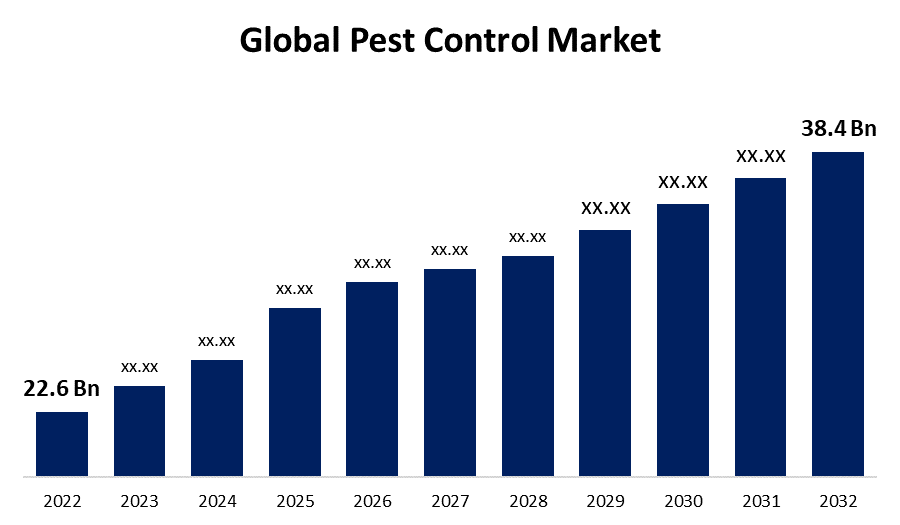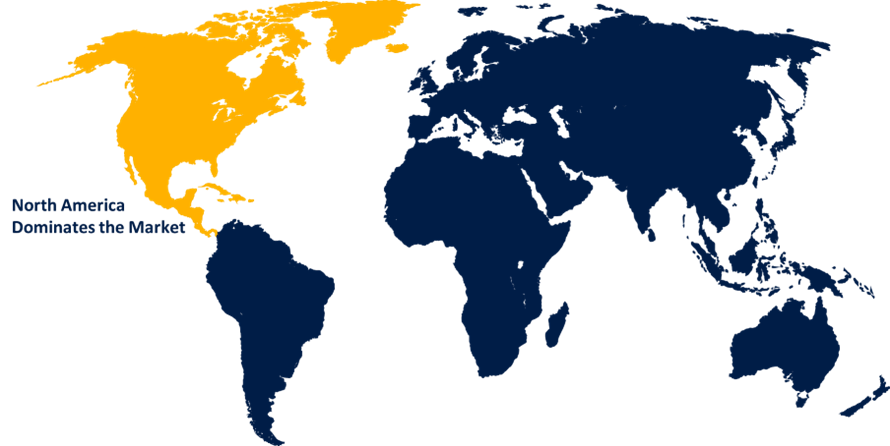Global Pest Control Market Size, Share, and COVID-19 Impact Analysis, By Control Method (Chemical, Mechanical, Biological, Software & Services), By Pest Type (Insects, Rodents, Termites, Wildlife), By Mode of Application (Sprays, Traps, Baits, Pellets, Powder), and By Region (North America, Europe, Asia-Pacific, Latin America, Middle East, and Africa), Analysis and Forecast 2022 – 2032
Industry: Chemicals & MaterialsGlobal Pest Control Market Insights Forecasts to 2032
- The Global Pest Control Market Size was valued at USD 22.6 Billion in 2022.
- The Market Size is Growing at a CAGR of 5.4% from 2022 to 2032
- The Worldwide Pest Control Market Size is expected to reach USD 38.4 Billion by 2032
- Asia Pacific is expected to Grow the fastest during the forecast period

Get more details on this report -
The Global Pest Control Market size is anticipated to exceed USD 38.4 Billion by 2032, growing at a CAGR of 5.4% from 2022 to 2032. The global pest control market has grown dramatically as a result of factors such as increased health and hygiene awareness, expanding urbanization, and rising demand for food protection.
Market Overview
The global pest control market includes a wide range of services, products, and strategies aimed at managing and mitigating the effects of pests on human health, agriculture, infrastructure, and the environment. Pests, which include insects, rodents, birds, and other organisms, can cause significant crop damage, spread diseases, contaminate food, and disrupt ecosystems. In response, the pest control industry provides a diverse range of solutions to these issues. Pest control methods vary and include chemical, biological, and physical methods. Pesticides are used in chemical methods to target and eliminate pests, whereas biological methods use natural predators, parasites, and pathogens to control pest populations. Physical techniques include the use of traps, barriers, and environmental modifications to prevent pest access. Agriculture depends heavily on pest control to ensure crop yield and quality, which contributes significantly to market growth. Pest control is also used in industries such as hospitality, healthcare, and residential services to keep environments safe and sanitary. As concerns about sustainability and the environment grow, there is a growing emphasis on integrated pest management (IPM) approaches that prioritize minimal ecological impact.
Report Coverage
This research report categorizes the market for the global pest control market based on various segments and regions and forecasts revenue growth and analyzes trends in each submarket. The report analyses the key growth drivers, opportunities, and challenges influencing the pest control market. Recent market developments and competitive strategies such as expansion, product launch, and development, partnership, merger, and acquisition have been included to draw the competitive landscape in the market. The report strategically identifies and profiles the key market players and analyses their core competencies in each sub-segment of the pest control market.
Global Pest Control Market Report Coverage
| Report Coverage | Details |
|---|---|
| Base Year: | 2022 |
| Market Size in 2022: | USD 22.6 Billion |
| Forecast Period: | 2022-2032 |
| Forecast Period CAGR 2022-2032 : | 5.4% |
| 2032 Value Projection: | USD 38.4 Billion |
| Historical Data for: | 2018-2021 |
| No. of Pages: | 200 |
| Tables, Charts & Figures: | 120 |
| Segments covered: | By Control Method, By Pest Type, By Mode of Application, By Region |
| Companies covered:: | Bayer AG, Corteva Agriscience, BASF SE, Sumitomo Chemical Co. Ltd., Syngenta AG, Rentokil Initial plc, Anticimex, Rollins, Inc. , ATGC Biotech Pvt Ltd., Ecolab Inc., FMC Corporation, De Sangosse , Bell Laboratories, PelGar International , Others And other key venders |
| Pitfalls & Challenges: | COVID-19 Empact,Challenges, Future, Growth, & Analysis |
Get more details on this report -
Driving Factors
Individuals, businesses, and governments are investing in effective pest control measures as they become more aware of the potential health risks associated with pests, such as disease transmission and allergies. The desire to maintain clean and safe environments is a major driver of pest control market growth. Rapid urbanization and population growth have resulted in denser living conditions, allowing pests to thrive. Pests find abundant food and shelter in cities, resulting in increased demand for pest control services in both residential and commercial settings. Agriculture feeds a large portion of the world's population, so pest control is critical to ensuring crop yield and food security. Pests can devastate crops, resulting in lower yields and economic losses. The agricultural sector's reliance on pest management products and techniques drives demand for novel and effective solutions.
Restraining Factors
To ensure the safety of humans, non-target species, and the environment, the pest control industry is subject to stringent regulations. These regulations can limit the types of chemicals that can be used, the methods of application, and the frequency of treatments. Navigating complex and evolving regulatory frameworks can pose compliance and operational flexibility challenges for businesses.
Market Segmentation
The Global Pest Control Market share is classified into control method, pest type, and mode of application.
- The Chemical segment is expected to hold the largest share of the global pest control market during the forecast period.
The global pest control market is categorized by control method into Chemical, Mechanical, Biological, Software & Services. Among these, the Chemical segment is expected to hold the largest share of the global pest control market during the forecast period. Pests are controlled and eradicated using various chemical formulations in the chemical segment of the pest control market. This includes insecticides, rodenticides, termiticides, and other pesticides. Chemical solutions are frequently effective in eliminating pests quickly.
- The Insects segment is expected to hold the largest share of the global pest control market during the forecast period.
Based on the pest type, the global pest control market is divided into Insects, Rodents, Termites, Wildlife. Among these, the Insects segment is expected to hold the largest share of the global pest control market during the forecast period. This is due to the sheer number and variety of insect pests that affect a wide range of industries, including residential, commercial, agricultural, and healthcare. Mosquitoes, for example, play a role in disease transmission, driving up demand for pest control services.
- The Sprays segment is expected to hold the largest share of the global pest control market during the forecast period.
Based on the mode of application, the global pest control market is divided into Sprays, Traps, Baits, Pellets, and Powder. Among these, the Sprays segment is expected to hold the largest share of the global pest control market during the forecast period. Pesticides and insecticides are applied using liquid formulations, often in aerosol cans or other spray devices, in the sprays segment of the pest control market. These sprays can be used both inside and outside to control a variety of pests, including insects and some rodents. They are easy to use and can cover large areas quickly.
Regional Segment Analysis of the Global Pest Control Market
- North America (U.S., Canada, Mexico)
- Europe (Germany, France, U.K., Italy, Spain, Rest of Europe)
- Asia-Pacific (China, Japan, India, Rest of APAC)
- South America (Brazil and the Rest of South America)
- The Middle East and Africa (UAE, South Africa, Rest of MEA)
North America is anticipated to hold the largest share of the global pest control market over the predicted timeframe.

Get more details on this report -
North America is projected to hold the largest share of the global pest control market over the predicted years. North America, which includes the United States and Canada, represents an important market for pest control services and products. Pest problems are exacerbated by the region's diverse climate and urbanization in the residential, commercial, and agricultural sectors. Rodents, insects, and termites are common pests. Stricter regulations and increased environmental awareness drive demand for integrated pest management (IPM) solutions and eco-friendly alternatives.
Asia Pacific is expected to grow at the fastest pace in the global pest control market during the forecast period. Because of its diverse climates and high rates of urbanization, the Asia-Pacific region faces a wide range of pest-related challenges. Pest control requirements differ greatly between countries such as China, India, Japan, and Australia. In addition to common pests like rodents and insects, there are mosquito-borne diseases and crop-damaging pests to contend with. A growing middle class, increased hygiene awareness, and changing agricultural practices are driving the market.
Competitive Analysis:
The report offers the appropriate analysis of the key organizations/companies involved within the global pest control along with a comparative evaluation primarily based on their product offering, business overviews, geographic presence, enterprise strategies, segment market share, and SWOT analysis. The report also provides an elaborative analysis focusing on the current news and developments of the companies, which includes product development, innovations, joint ventures, partnerships, mergers & acquisitions, strategic alliances, and others. This allows for the evaluation of the overall competition within the market.
List of Key Companies
- Bayer AG
- Corteva Agriscience
- BASF SE
- Sumitomo Chemical Co. Ltd.
- Syngenta AG
- Rentokil Initial plc
- Anticimex
- Rollins, Inc.
- ATGC Biotech Pvt Ltd.
- Ecolab Inc.
- FMC Corporation
- De Sangosse
- Bell Laboratories
- PelGar International
- Others
Key Target Audience
- Market Players
- Investors
- End-users
- Government Authorities
- Consulting And Research Firm
- Venture capitalists
- Value-Added Resellers (VARs)
Recent Developments
- In June 2023, Bayer AG's agricultural division, Bayer CropScience, collaborated with Crystal Crop Protection Ltd. to develop and launch groundbreaking pest control solutions for paddy growers across India. This collaboration marks a watershed moment in India's efforts to improve rice farmer yields and crop protection techniques.
Market Segment
This study forecasts revenue at global, regional, and country levels from 2020 to 2032. Spherical Insights has segmented the Global Pest Control Market based on the below-mentioned segments:
Global Pest Control Market, By Control Method
- Chemical
- Mechanical
- Biological
- Software & Services
Global Pest Control Market, By Pest Type
- Insects
- Rodents
- Termites
- Wildlife
Global Pest Control Market, By Mode of Application
- Sprays
- Traps
- Baits
- Pellets
- Powder
Global Pest Control Market, By Region
- North America
- US
- Canada
- Mexico
- Europe
- Germany
- Uk
- France
- Italy
- Spain
- Russia
- Rest of Europe
- Asia Pacific
- China
- Japan
- India
- South Korea
- Australia
- Rest of Asia Pacific
- South America
- Brazil
- Argentina
- Rest of South America
- Middle East & Africa
- UAE
- Saudi Arabia
- Qatar
- South Africa
- Rest of Middle East & Africa
Need help to buy this report?